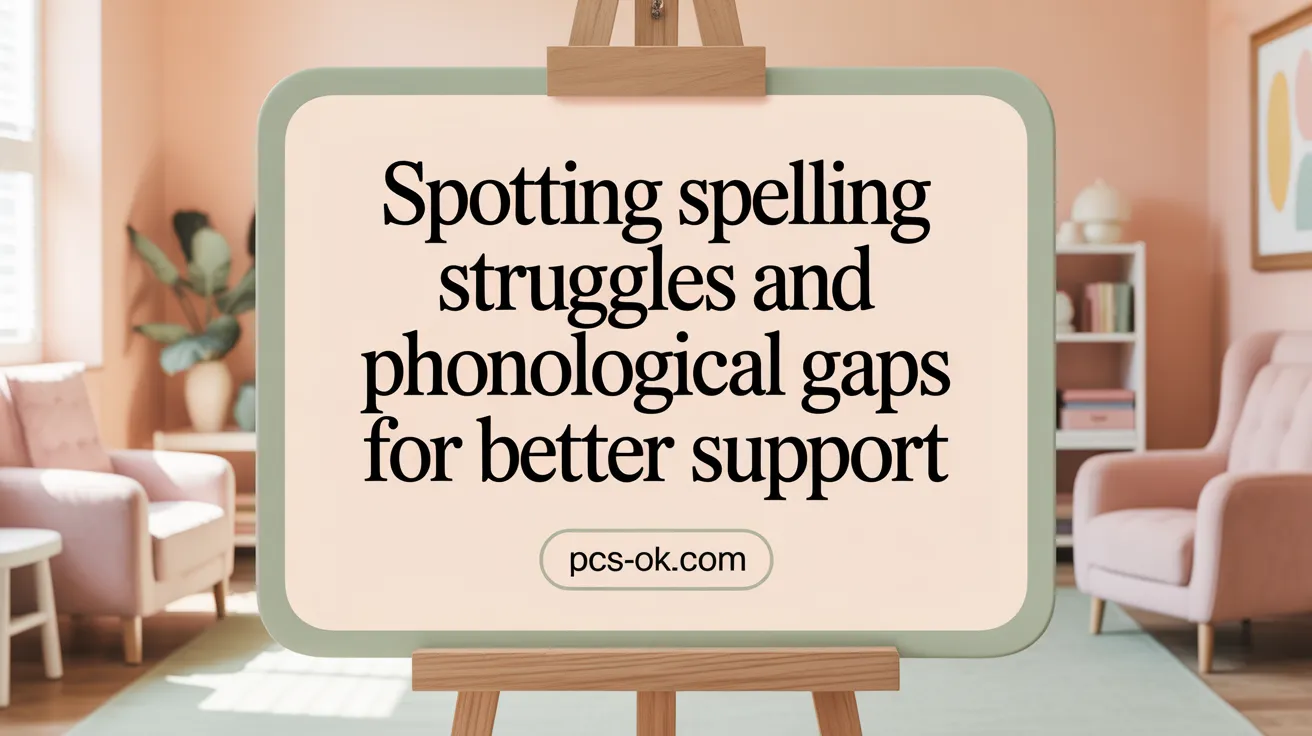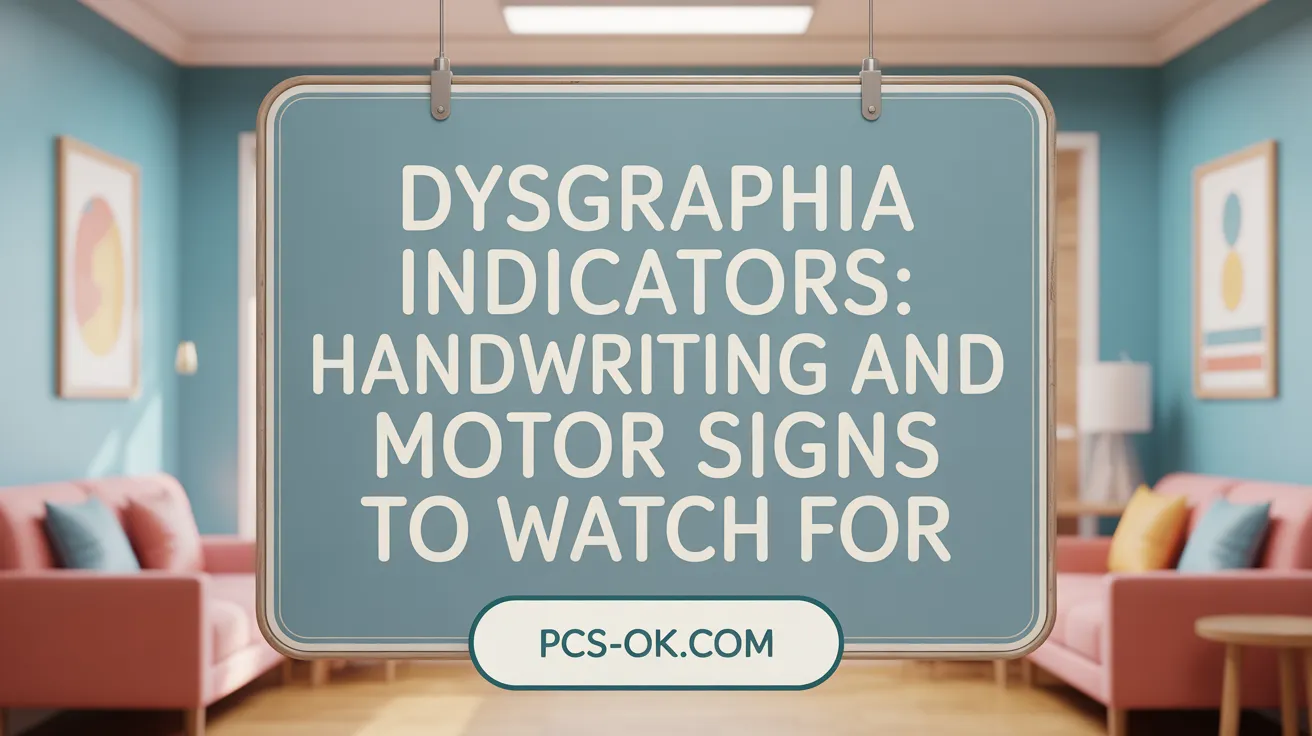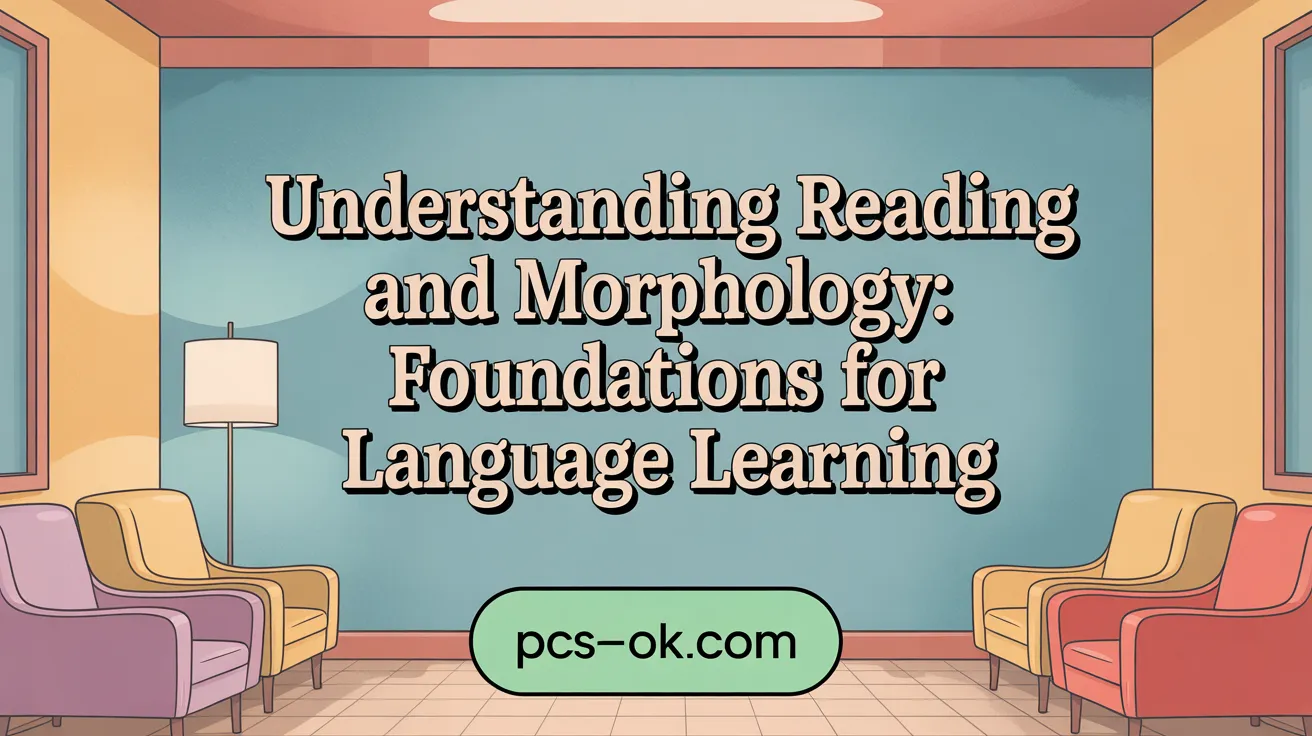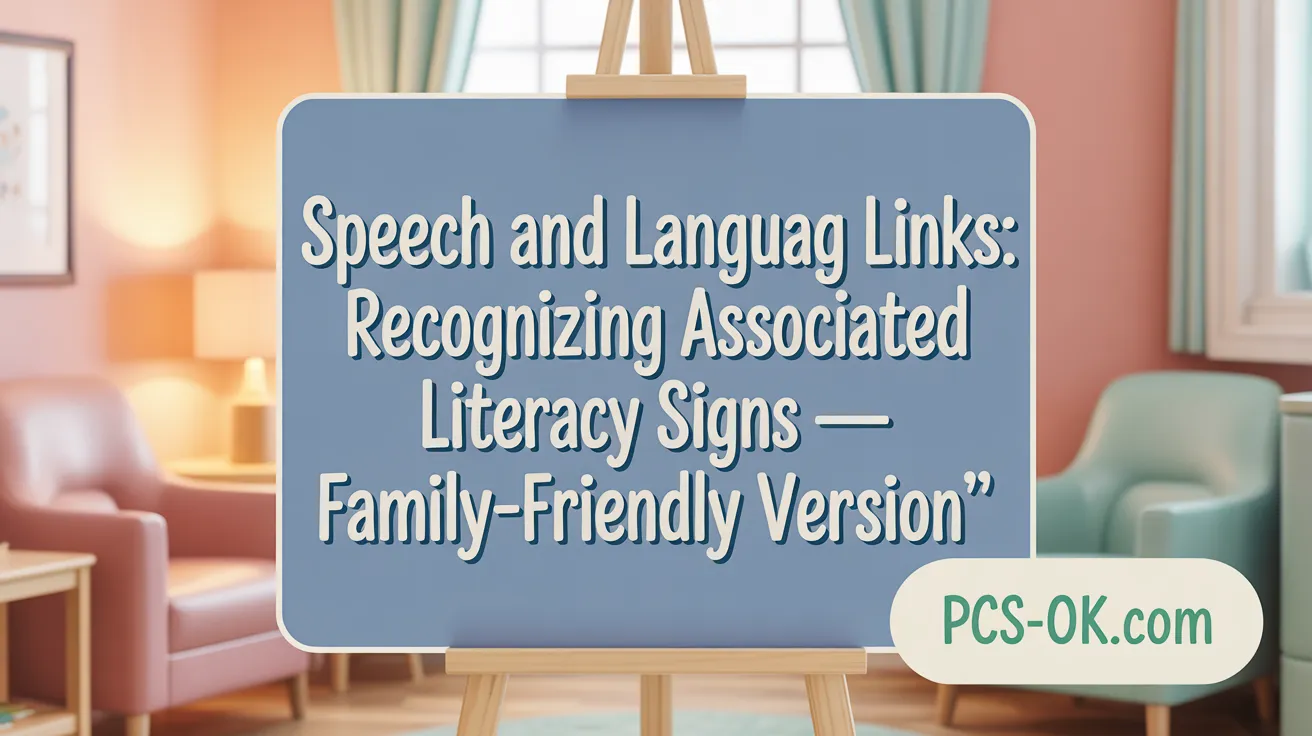7 Warning Signs of Written Language Disorders
Understanding Written Language Disorders
Written language disorders affect a child’s ability to read, write, and spell, often leading to academic and emotional challenges. Early recognition of warning signs can facilitate timely interventions, boosting literacy development and confidence. This article highlights seven critical warning signs of written language disorders across different developmental stages and writing skills, providing parents, educators, and professionals with crucial insights for early detection and support.
Key Facts on Children’s Literacy and Writing Disorders
- Early phonological deficits hinder recognition of sound patterns, impacting literacy development.
- Persistent spelling errors and phonological processing deficits are core indicators of written language disorders.
- Dysgraphia’s signs include poor handwriting, awkward grip, and disorganized writing, often requiring occupational therapy.
- Children with writing disorders struggle with organizing ideas, sentence structure, and genre understanding, affecting written expression.
- Decoding and morphological awareness deficits lead to slow reading, poor comprehension, and difficulty with academic discourse.
- Speech and language impairments often co-occur with literacy issues, especially in children with ADHD and autism spectrum disorder.
- Children with avoidance behaviors towards writing tasks exhibit frustration and low motivation, requiring early intervention.
- Early signs of written language disorders include delayed letter formation, limited print interest, and phonological deficits in preschool.
- Differentiating written language disorders from dyslexia and speech disorders involves interprofessional assessments of decoding, handwriting, and language skills.
- Screening, observation, and standardized assessments by educators and clinicians enable early detection and targeted intervention for writing difficulties.
1. Delayed Emergent Literacy Skills in Preschoolers

Early phonological awareness deficits
Initially, many preschool children with emerging language difficulties struggle to recognize patterns in sounds, such as rhymes or syllables. They may find it hard to identify individual sounds in words, which hampers their ability to develop phonological awareness—an essential skill for later reading and spelling.
Limited print recognition and interest
Young children showing signs of written language delay often show minimal interest in print. They might not recognize familiar symbols or letters, and may show little curiosity about reading books or writing activities. This lack of engagement can slow their literacy development.
Difficulty with letter recognition and print concepts
Children at this stage may also have trouble identifying alphabet letters or understanding that print carries meaning. For example, they may not know that words are made up of sounds or that written language represents spoken language.
Developmental milestones in emergent reading and writing
During typical development, preschoolers begin to recognize print in their environment, print simple words, and start pretending to read or write. When these skills are delayed, it can indicate a possible written language disorder. Signs include poor print awareness, limited interest in print, and difficulty recognizing and associating letters with sounds.
Understanding these early signs is vital for intervention. Recognizing that a child’s limited interest in print, difficulties with letter recognition, and phonological awareness deficits are indicators allows parents and educators to seek assessment and support early, increasing the chances for successful literacy development.
2. Persistent Spelling Difficulties and Phonological Processing Challenges

Children with written language disorders often experience ongoing struggles with spelling, a condition known as dysorthographia. These children tend to make frequent spelling errors, which can include inconsistent spelling of the same word, misspelling common words, or difficulty applying spelling rules. Such consistent difficulties interfere with their ability to write clearly and effectively.
Phonological processing deficits are at the core of these challenges. These deficits involve trouble recognizing, retrieving, and manipulating the sounds within words, impacting decoding skills. As a result, children may struggle to sound out unfamiliar words, which hampers both reading and spelling abilities.
The frequent spelling errors and decoding issues significantly affect word recognition and reading comprehension. When children cannot decode words accurately or recognize words effortlessly, their overall reading fluency decreases, making comprehension more difficult. This creates a cycle where poor decoding and spelling hinder understanding and learning across subjects.
In summary, persistent difficulties with spelling and phonological processing are strong indicators of written language disorders, requiring targeted assessment and intervention. Early support can help mitigate long-term academic challenges and promote literacy development.
3. Signs of Dysgraphia: Handwriting and Fine Motor Issues

Poor handwriting and inconsistent letter formation
Children with dysgraphia often exhibit handwriting that is difficult to read due to poorly formed, uneven, or reversed letters. Their handwriting may vary in size and spacing, making their work appear disorganized.
Awkward grip and body posture when writing
Young children may hold their pencils in an unusual way or sit with poor posture when writing. These habits can lead to fatigue and difficulty maintaining control over fine motor movements.
Difficulty staying within margins and uneven spacing
Students might struggle to keep their writing within designated margins. Their spacing between words and letters can be inconsistent, contributing to illegible work and difficulty with organization.
Writing fatigue and avoidance behaviors
Children often tire quickly when writing or drawing, displaying signs of frustration or avoidance. They may resist tasks that require handwriting, which can impact their learning and self-esteem.
Differentiation from other motor disorders
While dysgraphia shares some symptoms with other motor coordination issues like dyspraxia, signs specific to dysgraphia include difficulty with letter formation, spacing, and organization at the cognitive level, despite normal muscle strength.
Early identification of these signs allows for targeted interventions, such as occupational therapy, assistive technology, and classroom accommodations, helping children improve their writing skills and confidence.
4. Troubles with Written Expression and Organization

Difficulty organizing thoughts in writing
Children with written language disorders often struggle to organize their thoughts coherently in their writing. This difficulty can make their sentences appear jumbled, and they may have trouble presenting ideas in a logical sequence. As they progress through school, these challenges often become more apparent, especially when asked to write longer essays or reports.
Challenges in sentence structure and paragraph formation
Many children find it hard to construct well-formed sentences and develop clear paragraphs. They may write simple, choppy sentences or rely heavily on one or two sentence types. Paragraphs might lack topic sentences or contain unrelated ideas, which hampers overall clarity.
Confusion about different types of writing genres
A common sign of a written expression disorder is confusion regarding various writing genres, such as narratives, expositions, or argumentative essays. Children may have trouble understanding the purpose and structure required for each, affecting their ability to adapt their writing to different contexts.
Poor planning and revising skills
Children with these challenges often do not plan their writing before starting. They may skip the idea organization phase and jump straight into writing, leading to disorganized text. Additionally, they might have difficulties revising their work, failing to identify errors or areas needing improvement.
Developmental progression from simple to complex writing tasks
Initially, children may only produce basic sentences, but as they develop, expectations increase. A child with difficulties may struggle even with grade-level assignments involving multiple paragraphs, citations, and complex syntax. Recognizing this progression helps educators and parents identify when support or intervention is necessary.
| Age Range | Typical Signs | Writing Challenges | Supporting Strategies | Additional Notes |
|---|---|---|---|---|
| Preschool (3-5) | Minimal print interest, limited emergent skills | Basic scribbling, letter recognition difficulties | Engagement activities, read-alouds | Early signs may indicate future challenges |
| Early Elementary | Simple sentence writing, basic spelling errors | Difficulty with sentence structure, paragraphing | Scaffolded writing tasks, modeling | Ongoing assessment needed |
| Upper Elementary and Beyond | Simple sentences, disorganized ideas | Lack of planning, poor revising habits | Teaching outlines, graphic organizers | Support improves academic performance |
| Adolescence | Repetitive language, poor cohesion | Overuse of basic words, weak organization | Structured writing exercises | Often needs tailored interventions |
5. Reading Comprehension and Morphological Awareness Deficits

How do poor decoding skills lead to reading struggles?
Children with written language disorders often exhibit difficulty with decoding words, which affects their ability to read fluently. Decoding involves sounding out unfamiliar words using phonological and morphological cues. When this skill is impaired, children tend to read slowly or inaccurately, making comprehension more challenging. This struggle with decoding can cause frustration and hinder progress in academic settings.
What challenges do children face with understanding word structures and morphology?
Difficulty recognizing and understanding the structures within words—such as roots, prefixes, and suffixes—is common in children with language impairments. These morphological skills are essential for expanding vocabulary and deciphering unfamiliar words. When children are unable to grasp these components, they may misinterpret or struggle to learn new words, impacting their reading comprehension.
How do these deficits affect reading fluency and overall comprehension?
Fluency in reading depends heavily on decoding and morphological awareness. Children who lack these skills often read hesitantly, with frequent pauses or errors. This disfluency interrupts the flow of reading, making it difficult to understand the overall meaning of texts. Over time, poor fluency can lead to lower comprehension levels, affecting academic performance.
What are the struggles with academic discourse and genre recognition?
In addition to decoding challenges, children with written language disorders often find it difficult to recognize different genres and discourse components within texts. They may struggle to identify the purpose of a text, understand complex sentence structures, or use appropriate cohesive devices. These difficulties hamper their ability to analyze and produce various types of academic writing effectively.
6. Associated Signs in Children with Speech and Language Impairments

How are speech and written language difficulties connected?
Children with speech and language impairments often face challenges beyond just talking. They frequently show signs of struggles with both spoken and written language. For example, they might have trouble with vocabulary, forming sentences, or understanding how words work together.
What are signs of limited vocabulary or poor sentence construction?
Children with speech and language problems may use very few words or make sentences that are hard to understand. They might repeat words or phrases or omit important parts of a sentence, which impacts their ability to communicate clearly.
Are certain children at higher risk?
Yes, children diagnosed with ADHD or autism spectrum disorder tend to have a greater likelihood of also experiencing written language disorders. These children may show early signs like difficulty following directions or problems with reading and writing tasks.
Can early communication issues predict future problems?
Absolutely. Early signs such as not babbling, making few sounds, or not understanding speech sounds are strong indicators. If these issues are noticed during infancy or toddlerhood, they can signal future difficulties with spoken language, reading, and writing.
What is the role of speech-language pathologists?
Speech-language pathologists play a vital role in identifying and treating these impairments. They evaluate children’s speech and language skills, diagnose specific issues, and collaborate with families and schools to develop interventions. Their work ensures children receive early help, improving communication skills and academic success.
| Signs and Symptoms | Developmental Stage | Impact on Learning | Role of Intervention |
|---|---|---|---|
| Limited vocabulary | Preschool | Affects initial language development | Speech therapy to build vocabulary |
| Poor sentence formation | Early elementary | Impacts reading comprehension and writing | Language exercises focused on sentence complexity |
| Difficulties with decoding and spelling | Later elementary | Challenges in literacy skills | Phonological and morphological training |
| Signs in children with autism or ADHD | Any age | Increased risk for combined language and literacy issues | Interprofessional assessment and tailored therapy |
7. Avoidance of Writing Tasks and Low Motivation

Children with written language difficulties often show reluctance to engage in writing and drawing activities. They may avoid tasks that require holding a pen or pencil, shrinking away from drawing or copying exercises. This avoidance can stem from frustration or fear of making mistakes, leading to emotional impacts such as low self-esteem and increased anxiety about schoolwork.
Signs of fatigue and discomfort during writing are common. Children might complain of hand pain, tire quickly when writing, or develop shaky or inconsistent handwriting. Over time, these physical and emotional issues can contribute to a reluctance to participate in literacy activities.
The avoidance of writing tasks doesn’t just impact the ability to complete assignments; it can also significantly affect overall academic performance. Students may fall behind their peers, struggle to express their ideas clearly, and develop negative attitudes toward school.
Recognizing these signs early is essential. Early intervention can prevent secondary issues like low confidence and school avoidance. Teachers and parents should monitor children’s behaviors closely and seek assessments if avoidance and low motivation persist. Proper support and targeted strategies can help children build skills and confidence, fostering a more positive attitude toward writing and learning.
What are the warning signs and symptoms of written language disorders in children?
What are the warning signs and symptoms of written language disorders in children?
Children with written language disorders often show several observable signs that can help identify difficulties early on. These include persistent spelling challenges, where children make frequent mistakes or struggle to spell common words correctly. Their handwriting may be difficult to read, with inconsistent letter size, poor spacing, and trouble forming letters properly.
Beyond spelling and handwriting, these children often face challenges in organizing their ideas on paper. They may produce disorganized sentences, omit important details, or have trouble developing and revising their written work. This shows up as difficulty in planning and structuring essays or stories.
A core issue contributing to writing problems is phonological processing deficits. These can make it hard for children to decode words, connect sounds to letters, and understand reading comprehension, especially at early grades. Difficulties in phonemic awareness and sound retrieval affect their ability to spell and read fluently.
Many children with written language difficulties tend to avoid writing tasks altogether. They may display limited interest in print activities like reading or drawing and may find writing boring or frustrating. Their grammar and punctuation can also be immature or incorrect, further hindering clear communication.
Signs of such disorders are developmentally influenced. For example, young children might omit words or produce poorly formed letters, while older children and teenagers might struggle with organizing longer essays or creating complex arguments. Recognizing these symptoms allows for timely assessment and intervention.
Assessment by speech-language pathologists and educators is crucial for confirming diagnoses. Tailored support, including targeted writing exercises, phonological awareness training, and the use of assistive technology, can significantly improve literacy skills.
| Symptom Area | Typical Signs | Developmental Stage |
|---|---|---|
| Spelling | Frequent errors, inconsistent spelling | Early and school-age children |
| Handwriting | Poor letter formation, uneven spacing | Preschool to elementary |
| Organizing ideas | Disorganized sentences, omissions | Elementary and beyond |
| Phonological processing | Difficulty decoding, phoneme manipulation | Early grades to adolescence |
| Avoidance of tasks | Reluctance, limited print activity | All ages, especially with severe disorders |
Early recognition and intervention help children develop stronger literacy skills, boosting confidence and academic success.
What are the early indicators of written language disorders in children?
What are the early indicators of written language disorders in children?
Detecting written language disorders early can significantly improve outcomes for children. Several signs can indicate difficulties with written language development in preschool and early school years.
One of the most noticeable early signs is delayed writing milestones. Children may struggle with recognizing and forming letters, writing their names, or producing simple sentences. They might also have trouble with spelling basic words and putting ideas into correct sequence.
Limited print awareness is another key indicator. Children who do not understand that written words represent speech or have difficulty recognizing familiar symbols such as their own name in print are at risk. Additionally, a lack of interest in print activities, such as pretending to read or draw connections between spoken and written language, can signal underlying issues.
Phonological awareness deficits are prominent among children with speech or language impairments. These children may find it challenging to manipulate sounds within words, recognize rhyme patterns, or identify individual sounds, which are all essential for decoding and spelling.
Screening and assessment through speech-language pathologists and teachers are vital. Early evaluation helps identify these signs before they interfere with academic progress and provides opportunities for targeted intervention.
Overall, being aware of these developmental signs enables caregivers and educators to seek timely support, fostering better literacy development and confidence in young learners.
| Aspect | Typical Development | Signs of Concern | Additional Notes |
|---|---|---|---|
| Writing Milestones | Recognizing letters, copying simple shapes, basic spelling | Difficulty with letter recognition, spelling, sequencing | Delays may appear in preschool or early elementary years |
| Print Awareness | Understanding print as representing speech, recognizing familiar words | Limited or no recognition of print, disinterest in reading | Often noticed during emergent literacy activities |
| Phonological Skills | Manipulating sounds, rhyming, recognizing syllables | Struggling with sound manipulation and recognizing patterns | Common in children with speech/language impairments |
| Screening Importance | Regular assessment by professionals | Early identification and intervention improve literacy | Prevents long-term reading and writing challenges |
Early signs of written language disorders are subtle but gradually become more evident if not addressed. Recognizing these indicators allows for timely support, which is essential for helping children achieve literacy success.
How can dysgraphia and other literacy challenges be specifically recognized?
Indicators of dysgraphia
Dysgraphia manifests through various observable signs that can vary from early childhood onward. In young children, indicators include awkward grip or body position when holding a writing instrument, tire easily during writing tasks, and avoidance of handwriting or drawing activities. Poor letter formation, inverted or reversed letters, inconsistent spacing, and difficulty staying within margins are common among preschoolers and early elementary students.
As children grow, handwriting becomes less legible, and they may switch between cursive and print styles unexpectedly. Difficulties extend beyond motor skills to include trouble organizing ideas on paper, spelling errors, and poor punctuation usage. Older students might display disorganized writing, frequent revisions, and challenges with planning their essays or reports.
In adolescents and young adults, signs shift toward difficulties organizing written thoughts, developing coherent arguments, and maintaining proper syntax and grammar in writing—especially visible in academic settings.
Handwriting and spelling difficulties
Children with dysgraphia often struggle with forming letters correctly and consistently. Their handwriting can appear messy, uneven in size, and poorly aligned. They may have trouble with spacing, difficulty staying within the lines or margins, and show a tendency to avoid writing altogether.
Spelling problems are also prevalent. These include frequent misspellings, inconsistent spelling patterns, and difficulty applying phonetic rules. Such issues are evident in both the decoding of words and their reproduction in writing.
Professional assessment tools
Diagnosis of dysgraphia involves comprehensive evaluation by professionals. Occupational therapists conduct handwriting assessments focusing on motor planning, coordination, and the physical aspects of writing. Speech-language pathologists may evaluate orthographic processing, spelling, and written language skills.
Standardized tools, such as handwriting speed tests, spelling inventories, and writing samples analyzed for organization and coherence, help in identifying the severity of the disorder. Neuropsychological testing can explore underlying cognitive functions, including visual-motor integration and language processing. These assessments confirm whether difficulties are specific to writing skills or related to broader learning or developmental challenges.
Early intervention importance
Recognizing signs early in a child’s development is crucial. Early diagnosis allows for tailored interventions that target specific weaknesses, such as fine motor skills or orthographic spelling strategies. Use of assistive technology, specialized writing programs, and occupational therapy can significantly improve handwriting quality and writing confidence.
Proactive responses prevent frustration, reduce the risk of academic decline, and foster positive attitudes toward writing and learning. Collaboration among teachers, therapists, and parents ensures children receive consistent support, leading to better educational and social outcomes.
| Signs of Dysgraphia | Example Behaviors | Recommended Interventions |
|---|---|---|
| Poor handwriting | Illegible or inconsistent letter formation | Occupational therapy, handwriting practice |
| Spelling errors | Frequent misspellings, poor phonetic awareness | Spelling strategies, phonological awareness exercises |
| Avoidance of writing tasks | Resistance, fatigue during homework | Accommodations like typing, assistive devices |
| Planning difficulties | Disorganized sentences, poor structure | Graphic organizers, writing scaffolding |
| Physical discomfort | Hand pain, fatigue | Hand strengthening activities, ergonomic tools |
Early identification and intervention are essential for helping children overcome literacy challenges related to dysgraphia. When guided by specialists and supported at home and school, children can develop more effective writing skills, boosting their confidence and academic performance.
How can written language disorders be differentiated from related conditions?
Diagnostic distinctions from dyslexia and speech disorders
Written language disorders are primarily characterized by difficulties in spelling, handwriting, and expressing ideas through written text. Unlike dyslexia, which mostly impacts the ability to decode words, recognize print, and read fluently, written language disorders involve challenges in translating language into written form. Speech disorders, on the other hand, chiefly involve difficulties in articulation, voice, or fluency when speaking, but do not necessarily affect written language proficiency.
In diagnosing these conditions, professionals look for specific patterns of difficulty. For instance, children with dysgraphia may struggle with letter formation, spacing, and organizing ideas on paper, while children with speech sound disorders may not show significant handwriting issues but have speech articulation problems.
Role of interprofessional teams
Assessment and diagnosis require a collaborative approach involving speech-language pathologists, occupational therapists, reading specialists, psychologists, and teachers. These professionals conduct various formal and informal evaluations to identify the child’s unique profile of strengths and weaknesses.
Team members may utilize standardized tests for reading, spelling, handwriting, and language comprehension alongside observational assessments and developmental history reviews. This multidisciplinary approach ensures a comprehensive understanding, aiding accurate differentiation from other conditions.
Assessment methods and behavioral profiles
Evaluations often include measures of phonological processing, morphological awareness, syntax, semantic understanding, and pragmatic language skills. Observations focus on how the child writes stories, organizes ideas, and maintains coherence in written work.
Behaviorally, children with written language disorders may avoid writing tasks, show poor handwriting quality, or struggle with spelling and punctuation, despite having adequate oral language skills. Conversely, children with speech or language disorders might not exhibit these specific writing issues but will face challenges in speech production or comprehension.
Recognizing developmental milestones and monitoring progress over time are essential, as persistent difficulties in specific areas suggest a true written language disorder rather than a temporary or related issue.
| Condition | Main Impact | Diagnostic Focus | Typical Signs | Associated Factors |
|---|---|---|---|---|
| Dyslexia | Reading decoding and fluency | Reading tests, phonological awareness | Difficulty recognizing print, decoding | Family history, auditory processing issues |
| Dysgraphia | Handwriting and spelling | Handwriting observation, spelling tests | Illegible handwriting, spacing issues | Fine motor skills, organizational difficulties |
| Speech/Language Disorder | Spoken language and vocabulary | Speech articulation exams, language assessments | Inconsistent speech sounds, limited vocabulary | Otitis media history, neurological factors |
Understanding these distinctions, maintaining awareness of developmental patterns, and conducting thorough assessments enable professionals to differentiate written language disorders from other conditions, ensuring targeted and effective interventions.
What strategies exist for early detection and diagnosis of writing difficulties?
Screening and observation techniques
Early detection of writing difficulties often relies on systematic screening in preschool and early elementary settings. Teachers observe children’s handwriting, spelling, and writing behaviors during classroom activities, paying attention to inconsistent letter formation, spacing issues, and avoidance of writing tasks. Informal assessments like writing samples and developmental milestone checklists can reveal early signs of dysgraphia or other writing challenges. Monitoring children’s ability to copy shapes, form letters, and organize thoughts on paper helps pinpoint areas needing support.
Standardized writing assessments
Standardized tests provide a more formal approach to diagnosing writing disorders. These assessments evaluate various skills, such as letter speed, legibility, spelling accuracy, and coherence of written expression. They often include tasks like paragraph composition, sentence structure analysis, and spelling tests designed to identify specific deficits. Additionally, assessments of fine motor skills and visual-motor integration help distinguish between motor coordination issues and genuine written language disorders.
Role of parents and educators
Parents and teachers are essential in early detection. Parents can report concerns based on home observations, such as frequent erasures, slow progress, or frustration during writing activities. Educators can implement informal screening tools, observe children across different contexts, and refer at-risk students for further evaluation. Collaboration among teachers, parents, and health professionals ensures a comprehensive understanding of the child’s writing abilities.
Intervention timing and methods
Early identification enables timely intervention, which is critical because skills developed in early childhood set the foundation for later academic success. Approaches include multisensory teaching methods, occupational therapy focusing on motor skills, and accommodations like extended time or speech-to-text software. Interventions should be tailored to the child’s specific needs, focusing on improving handwriting, spelling, and written expression through explicit instruction and practice. Ongoing assessment helps adapt strategies to maximize progress and confidence.
| Strategy Type | Description | Targeted Skills | Implementation Example |
|---|---|---|---|
| Screening | Routine classroom checks | Handwriting, spelling, organization | Checklists, observation forms |
| Formal Testing | Standardized assessments | Letter formation, spelling accuracy | Use of tools like the Test of Written Language |
| Teacher & Parent Reports | Continuous observation | Writing habits, frustration signs | Surveys, open communication |
| Early Intervention | Targeted instruction and therapy | Motor control, decoding, organization | Multisensory activities, OT support |
Recognizing early signs of writing difficulties through these combined strategies can lead to effective support, improving a child’s academic trajectory and self-esteem.
What are the developmental characteristics of writing disorders in children?
What are the developmental characteristics of writing disorders in children?
Developmental writing disorders, such as dysgraphia, manifest as difficulties in acquiring and demonstrating age-appropriate writing skills, including handwriting, spelling, and organizing ideas on paper. These challenges often originate from neurological and motor factors that influence fine motor control, orthographic processing (the ability to recognize and remember letter patterns), language expression, and cognitive organization.
Initially, young children might display concrete motor impairments, such as poorly formed letters, reversed or inconsistent letter placement, and struggles with spacing and margins. These signs are particularly noticeable in preschool and early school years. As children grow and their writing tasks become more complex, their difficulties often expand from these motor and visual issues to include problems with syntax, sentence structure, and coherent composition.
The progression of symptoms can vary, but typically, early signs of writing disorder include awkward grip and fatigue during writing activities, poor handwriting, and avoidance of writing tasks. With increased academic demands, children might also show struggles with spelling, organizing longer paragraphs, and developing arguments or narratives, reflecting more abstract cognitive challenges.
Unaddressed, these ongoing difficulties can lead to emotional issues such as frustration, low self-esteem, and anxiety related to academic performance. Children might become discouraged or avoid schoolwork altogether, which can further hinder their skill development.
Recognizing these developmental patterns early is crucial. Early diagnosis allows for targeted interventions, including occupational therapy, specialized teaching strategies, and accommodations that support handwriting and organizational skills. Such proactive steps can improve outcomes by fostering skill development, boosting confidence, and preventing secondary emotional impacts.
In summary, the trajectory of writing disorders involves a shift from basic motor and visual challenges to more complex language and organizational struggles. Understanding this developmental pathway is essential for educators, clinicians, and parents to support affected children effectively.
What are the implications of written language disorders and what support strategies are effective?
Written language disorders can significantly impact a child’s academic performance and emotional well-being. Difficulties with spelling, handwriting, organizing ideas, and articulating thoughts clearly may cause frustration, low self-esteem, and decreased motivation to learn. These challenges often extend beyond academics, affecting a child’s confidence and social interactions.
Early diagnosis and intervention are vital. Speech-language pathologists (SLPs) play a critical role in assessing, diagnosing, and developing individualized treatment plans for children with these disorders. Their expertise helps differentiate between casual writing struggles and more persistent written language impairments while considering cultural and linguistic backgrounds.
Effective support strategies encompass explicit instruction tailored to the child’s developmental level. For example, teaching specific writing skills, using visual supports, and providing structured models can aid progress. Incorporating assistive technologies like word processors with spell check, speech-to-text tools, and graphic organizers allows children to express themselves more effectively and with less frustration.
Collaboration among educators, families, and professionals is essential. Implementing a multitiered system such as Response to Intervention (RTI) ensures that children receive appropriate levels of support early on. Regular communication helps monitor progress, adjust strategies, and foster consistency across settings.
Furthermore, accommodations such as extended time on assignments, breaking tasks into smaller steps, and providing alternative ways to demonstrate understanding can make learning more accessible. Creating a positive, inclusive classroom environment encourages risk-taking and resilience.
Fostering self-regulation, confidence, and motivation is equally important. Encouragement, celebrating small successes, and building on the child’s strengths help develop a growth mindset. Strengthening foundational spoken language and executive functions like planning, monitoring, and self-correction are integral components of effective intervention.
Overall, addressing written language disorders comprehensively supports not only literacy development but also the child’s emotional health and social competence, laying a foundation for lifelong learning and communication skills.
| Implication Area | Support Strategy | How It Helps |
|---|---|---|
| Academic | Explicit instruction | Improves specific writing skills |
| Emotional | Encouragement and positive reinforcement | Builds confidence and motivation |
| Technological | Assistive tools (spell check, speech-to-text) | Facilitates expression and reduces frustration |
| Collaborative | Teacher-parent-professional teamwork | Ensures consistent support and progress tracking |
| Accommodations | Modified tasks, extended time | Increases access and reduces anxiety |
Addressing Written Language Disorders Early for Better Outcomes
Recognizing the warning signs of written language disorders throughout childhood is essential for timely intervention and support. From early phonological awareness deficits to challenges with handwriting, spelling, and written expression, these signs can hinder academic progress and emotional well-being if left unaddressed. Collaborative efforts among parents, educators, and healthcare professionals, particularly speech-language pathologists, play a vital role in assessment, diagnosis, and individualized intervention. With appropriate support, children with written language disorders can develop their literacy skills, enhance their confidence, and achieve greater success in school and beyond.
References
- Signs and Symptoms of Written Language Disorders
- Written Language Disorders
- Signs of Speech and Language Disorders
- 7 Dysgraphia symptoms in children
- Signs your child may have a speech or language disorder
- Signs of written expression disorder
- Disorder of written expression and dysgraphia: definition, …
- Think Your Child Has a Written Language Disorder? Pediatric …
- Language Disorders in Children
